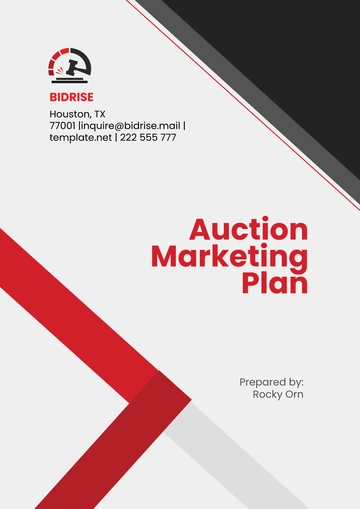Free Jewelry Store Marketing Plan

I. Executive Summary
The purpose of this marketing plan is to outline the strategies and tactics [Your Company Name] will employ to increase brand awareness, attract more customers, and boost sales over the next year. In a competitive jewelry market, it is essential to differentiate our offerings while connecting with our target audience. We aim to showcase our unique designs, quality craftsmanship, and exceptional customer service through both traditional and digital marketing channels. By combining social media campaigns, search engine optimization (SEO), and local advertising, we intend to reach potential customers at various touchpoints, enhancing their overall experience with our brand.
Leveraging an omnichannel marketing approach, [Your Company Name] will ensure cohesiveness and consistency across all platforms. This strategy involves utilizing our physical store presence alongside an engaging online experience, fostering a seamless transition between the two. Our marketing initiatives will focus on promoting seasonal collections, hosting in-store events, and engaging customers through loyalty programs. By harnessing customer feedback and analyzing market trends, we will continuously refine our tactics to better meet the needs and preferences of our clientele. Our goal is not only to drive immediate sales but also to cultivate lasting relationships with customers, positioning [Your Company Name] as their preferred jewelry destination.
II. Market Analysis
A. Industry Overview
In recent years, the jewelry industry has demonstrated steady growth, driven by evolving consumer preferences and technological advancements. Notably, trends such as personalized jewelry and lab-grown diamonds are gaining significant traction, reflecting a shift toward sustainability and individuality in jewelry purchasing. According to the National Gems Journal (NGJ), the industry is projected to grow at an annual rate of 5%, indicating a robust market opportunity for innovative and customer-centric brands. As consumers increasingly seek meaningful and ethical choices, businesses that adapt to these trends will be well-positioned for success.
B. Target Market
Our primary target market consists of individuals aged 25 to 45, predominantly urban dwellers with a disposable income who prioritize quality and craftsmanship in their jewelry purchases. This demographic is often characterized by a desire for unique, meaningful pieces that express their individuality and values. Additionally, we identify secondary target markets, including gift-buyers seeking special occasions and wedding couples looking for engagement and wedding rings. Understanding these segments allows [Your Company Name] to tailor marketing messages and product offerings to resonate deeply with each group's preferences and needs.
C. Competitor Analysis
[Your Company Name] faces competition from both luxury jewelry brands and fast-fashion jewelry retailers, each appealing to different segments of the market. Luxury brands often emphasize exclusivity and heritage, while fast-fashion retailers compete on price and trendiness. To differentiate ourselves within this crowded marketplace, we focus on offering a unique blend of classic and contemporary designs at competitive prices, paired with exceptional customer service. By highlighting our commitment to quality, craftsmanship, and personalized experiences, we aim to capture the interest of discerning consumers who seek value without compromising style. Our analysis will continue to evolve, allowing us to adapt to market shifts and competitive pressures effectively.
III. Marketing Objectives
To guide our efforts effectively, [Your Company Name] has established clear and measurable marketing objectives aimed at driving growth and enhancing customer engagement over the next year.
Increase brand awareness by 30% over the next year.
Achieve a 20% increase in retail and online sales by Q4.
Expand customer base in the 25-45 age demographic by 15%.
IV. Marketing Strategies
A. Branding and Positioning
To solidify our reputation as a leader in sustainable jewelry practices, [Your Company Name] will enhance its brand identity through a comprehensive rebranding initiative. This will include the development of an updated logo and a memorable slogan that encapsulates our commitment to ethical sourcing and craftsmanship. By aligning our visual identity with our core values, we aim to create a strong emotional connection with customers who prioritize sustainability. This strategic positioning will not only differentiate us in a competitive market but also resonate with a growing demographic of environmentally conscious consumers.
B. Digital Marketing
1. Website Optimization
To improve customer experience and drive sales, we will undertake a complete revamp of our website. Key enhancements will focus on mobile responsiveness, ensuring that users can easily navigate our site from any device. Fast load times will be prioritized to reduce bounce rates, while seamless integration with e-commerce platforms will facilitate straightforward transactions. Additionally, we will implement SEO best practices to improve search visibility, ensuring that potential customers can easily discover our products online.
2. Social Media Engagement
Develop a content calendar for regular posts on Instagram, Facebook, and Pinterest.
Utilize engaging storytelling techniques including high-quality images and customer testimonials.
3. Email Campaigns
To keep our audience informed and engaged, we will launch a monthly newsletter that highlights new collections, special sales, and jewelry care tips. This will not only serve as a platform to showcase our latest offerings but also provide value to our customers by educating them on how to care for their purchases. Personalized email campaigns will target specific segments of our customer base, increasing open rates and encouraging repeat purchases.
C. Offline Marketing
1. In-Store Promotions
To drive foot traffic and create a sense of exclusivity, [Your Company Name] will host quarterly in-store events featuring exclusive previews of new collections. These events will be designed to enhance customer experience, offering refreshments, live demonstrations, and opportunities to engage directly with our artisans and designers. By fostering a welcoming atmosphere, we aim to strengthen customer relationships and encourage word-of-mouth referrals.
2. Collaborations with local artisans
To further enhance our brand's community ties and promote local craftsmanship, we will actively foster partnerships with local artisans. These collaborations will result in the co-creation of limited-edition pieces that celebrate the artistry and heritage of our region. By supporting community artisans, we not only enrich our product offerings but also position [Your Company Name] as a champion of local creativity, attracting customers who value unique, handcrafted jewelry. This initiative will be promoted through both online and offline channels, highlighting our commitment to supporting local talent and sustainable practices.
V. Budget Allocation
Effective budget allocation is critical to the success of [Your Company Name]'s marketing strategies. This section outlines the financial resources dedicated to each marketing initiative, ensuring that we maximize our return on investment while supporting our overall objectives for brand awareness, customer engagement, and sales growth in the coming year.
Category | Budget |
|---|---|
Digital Marketing | $40,000 |
In-Store Promotions | $25,000 |
Print Advertising | $15,000 |
Local Collaborations | $10,000 |
VI. Evaluation and Control
A. Key Performance Indicators (KPIs)
To ensure the success of our marketing initiatives and to track progress toward our objectives, [Your Company Name] will utilize several Key Performance Indicators (KPIs). These metrics will provide valuable insights into our performance and guide our decision-making:
Monthly Website Traffic and Conversion Rates: Monitoring website traffic will help us understand customer interest and engagement with our brand. Conversion rates will indicate how effectively we turn visitors into buyers, allowing us to optimize our online presence.
Social Media Engagement Metrics: We will track engagement rates across our social media platforms, including likes, shares, comments, and follower growth. These metrics will help us gauge the effectiveness of our content and identify opportunities for deeper customer engagement.
Sales Growth by Demographic Segment: Analyzing sales data by demographic segments will allow us to assess how well we are reaching our target markets. This analysis will inform future marketing efforts and product development strategies.
B. Adjustments
To maintain alignment with our marketing goals and adapt to changing market conditions, [Your Company Name] will conduct quarterly reviews of our strategies. During these evaluations, we will analyze performance data from our KPIs to assess the effectiveness of our marketing initiatives. Based on this analysis, we will make necessary adjustments, whether that involves reallocating resources, refining our messaging, or exploring new marketing channels. This proactive approach will ensure that we remain agile and responsive to customer needs and market trends, ultimately driving sustained growth and success.
This marketing plan outlines a comprehensive strategy for [Your Company Name] to enhance brand awareness, engage customers, and drive sales growth in the competitive jewelry market. By leveraging both digital and traditional marketing approaches, alongside a strong commitment to sustainability and local craftsmanship, we aim to establish ourselves as the preferred destination for quality jewelry. Our ongoing evaluation will ensure we remain adaptable and responsive to the evolving needs of our customers.
- 100% Customizable, free editor
- Access 1 Million+ Templates, photo’s & graphics
- Download or share as a template
- Click and replace photos, graphics, text, backgrounds
- Resize, crop, AI write & more
- Access advanced editor
Elevate your marketing efforts with this Jewelry Store Marketing Plan Template from Template.net. This customizable and editable template provides a comprehensive structure for outlining your marketing strategies, target audience, and promotional activities. Fully editable in our Ai Editor Tool, you can tailor each section to meet your specific goals, ensuring an effective and well-organized marketing plan for your jewelry store.





























